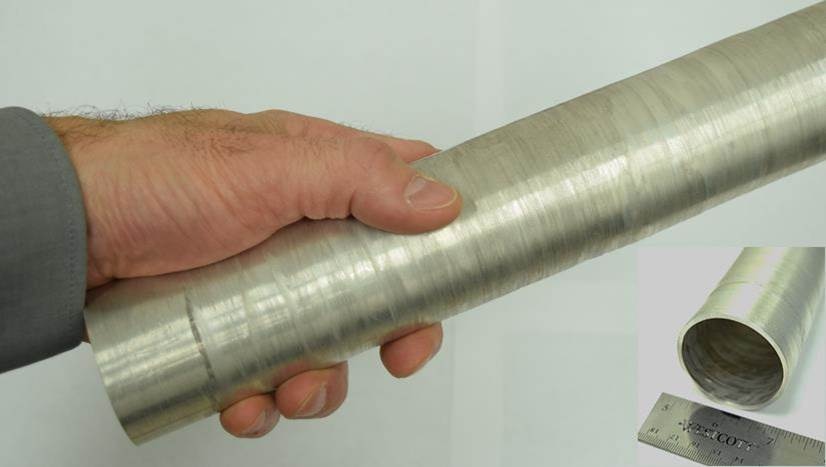Aug 23 2017
Considered as the lightest of all structural metals, magnesium has a lot going for it in the mission to manufacture ever lighter trucks and cars that go farther on a battery charge or a tank of fuel.
 A 50 mm diameter tube with a 1.5 mm wall thickness created from a solid chunk of magnesium alloy using PNNL's ShAPE™ extrusion process. (Credit: PNNL)
A 50 mm diameter tube with a 1.5 mm wall thickness created from a solid chunk of magnesium alloy using PNNL's ShAPE™ extrusion process. (Credit: PNNL)
Magnesium is the fourth most common element on earth behind iron, silicon and oxygen, and is 75% lighter than steel and 33% lighter than aluminum. But regardless of its light weight and natural abundance, auto manufacturers have been thwarted in their attempts to add magnesium alloys into structural car parts. To provide the needed strength has required the addition of expensive, rare elements such as praseodymium, dysprosium and ytterbium — so far.
A new process created at the Department of Energy's Pacific Northwest National Laboratory, should make it more achievable for the auto sector to integrate magnesium alloys into structural components. The technique has the potential to lower cost by eliminating the need for rare-earth elements, while simultaneously enhancing the material's structural properties. It is a novel twist on extrusion, in which the metal is pushed through a tool to form a specific shape, quite like dough that is pushed through a pasta maker to create different shapes.
Preliminary research, described recently in Materials Science and Engineering A, and Magnesium Technology, found the PNNL-developed process impressively enhances the energy absorption of magnesium by developing novel microstructures that cannot be achieved with traditional extrusion techniques. It also enhances ductility — the maximum point the metal can be stretched before it breaks. These improvements make magnesium easier to work with and more probable to be used in structural car parts. Presently, magnesium components make up only around 1%, or 33 pounds, of a standard car's weight according to a DOE report.
Today, many vehicle manufacturers do not use magnesium in structural locations because of the two Ps; price and properties. Right now, manufacturers opt for low-cost aluminum in components such as bumper beams and crush tips. Using our process, we have enhanced the mechanical properties of magnesium to the point where it can now be considered instead of aluminum for these applications — without the added cost of rare-earth elements.
Scott Whalen, Principal Investigator and Mechanical Engineer
A new spin on things
Researchers hypothesized that spinning the magnesium alloy during the extrusion process would generate just sufficient heat to soften the material so it could be easily forced through a die to create rods, tubes, and channels. Heat produced from mechanical friction deforming the metal, provides all of the heat essential for the process, eliminating the need for high energy consuming resistance heaters used in traditional extrusion presses.
The shape of things to come
The PNNL team designed and commissioned an industrial version of their idea and received an exclusive, tailor-made Shear Assisted Processing and Extrusion machine — giving rise to the acronym for ShAPE™.
Using it, they have effectively extruded very thin-walled round tubing, up to two inches in diameter, from magnesium-aluminum-zinc alloys ZK60A and AZ91, enhancing their mechanical properties in the process. For instance, room temperature ductility beyond 25% has been independently measured, which is a huge improvement compared to standard extrusions.
In the ShAPE™ process, we get highly refined microstructures within the metal and, in some cases, are even able to form nanostructured features. The higher the rotations per minute, the smaller the grains become which makes the tubing stronger and more ductile or pliable. Additionally, we can control the orientation of the crystalline structures in the metal to improve the energy absorption of magnesium so it's equal to that of aluminum.
Scott Whalen, Principal Investigator and Mechanical Engineer
The push to save energy
The chunks or billets of bulk magnesium alloys flow through the die in a very soft state, thanks to the concurrent rotational and linear forces of the ShAPE™ machine. This means just one tenth of the force is required to push the material through a die compared to traditional extrusion.
This important reduction in force would enable considerably smaller production machinery, thus decreasing capital expenditures and operations costs for industry choosing to use of this patent pending process. The force is so low that the quantity of electricity used to create a one-foot length of two-inch diameter tubing is around the same as it takes to power a residential kitchen oven for just 60 seconds.
Energy is saved as the heat produced at the billet/die interface is the only process heat essential to soften the magnesium.
We don't need giant heaters surrounding the billets of magnesium like industrial extrusion machines. We are heating — with friction only — right at the place that matters.
Scott Whalen, Principal Investigator and Mechanical Engineer
Magna-Cosma, a global auto industry parts supplier, is partnering with PNNL on this DOE funded research project to improve low cost magnesium parts and, as larger tubes are manufactured, will be testing them at one of their production facilities near Detroit.
PNNL's ShAPE™ technology is available for licensing and could help to make a dent in the auto industry's magnesium target, and trim down cars which presently weigh about 3,360 pounds.
PNNL’s ShAPE™ Extrusion Process